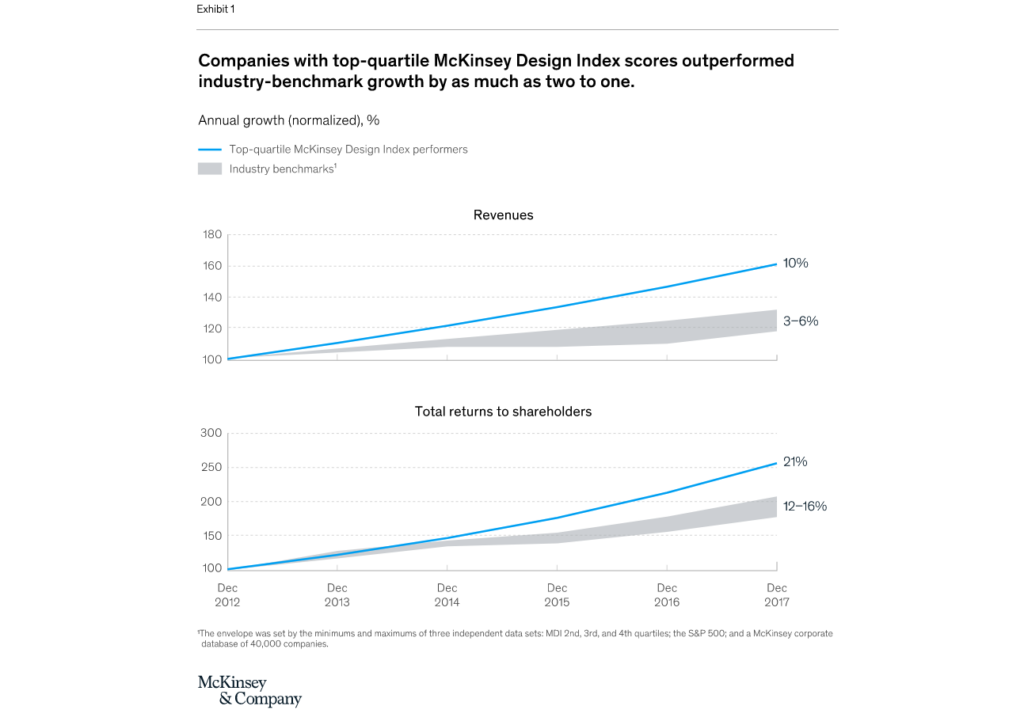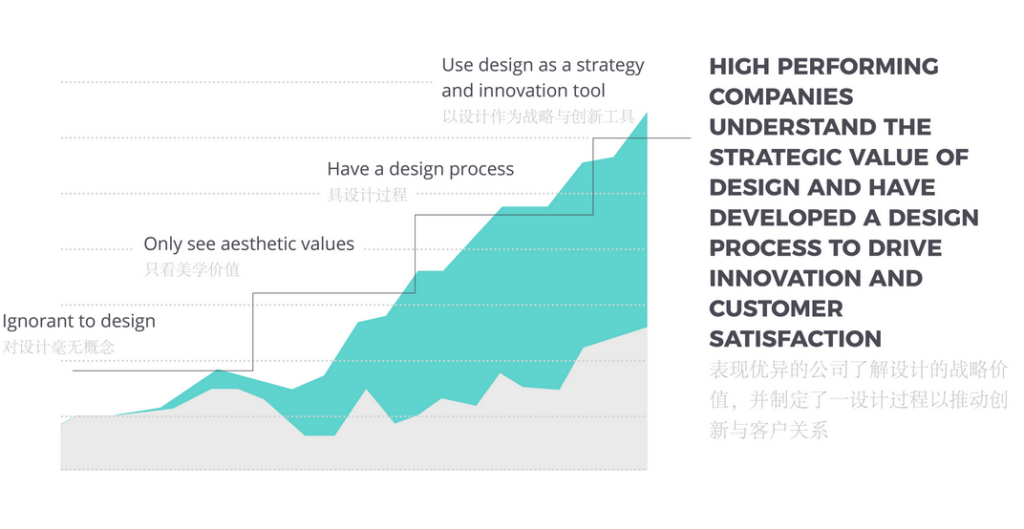I’m surprised that I still meet many companies that only see design as an aestethic value and fail to see the link between design and good business. I felt compelled to write up my thoughts and highlight my 5 strongest documented arguments for how design add shareholder value.
In 2019, McKinsey worked with a leading European airline to improve their revenue management system. The airline was facing intense competition and needed to optimize their pricing and inventory management to remain competitive. McKinsey used a combination of data analysis and design thinking to develop a new revenue management system that incorporated customer preferences, market trends, and operational constraints. The new system enabled the airline to increase its revenue by 2-3% and improve customer satisfaction by offering more personalized pricing options.
This is just one of the many examples illustrating how the business world is not only finding design an indispensable element to create success, but also one that is worthy of paying big bucks for.
They are of course not doing it on a whim. Studies show that they are definitely on the right track. Microsoft funded DMI (Design Management Institute) to create a ‘Design Value Index’ studying the performance of selected US publicly held design-led companies. The results are astonishing: from 2004 – 2014, the design-led companies outperformed the overall S&P 500 Index by a whopping 219%
The research has continued and Mckinsey published The Business Value of design. in 2018 and confirm these outrageous number.

It is therefore clear that companies that recognize design as a strategic asset (rather then just its aesthetic value) perform much better than companies that do not.
Both UK and Sweden follow the same trend as in the US survey. The Design Index studies conducted by the Design Council of UK tracked 61 design-led household brands and found that they outperformed FTSE 100 by over 200% in a 10-year period. The Swedish Industrial Design Foundation went further by placing companies on a “design ladder”, with those that place on the top strategic importance on design driving the highest shareholder value, in comparison to businesses that are ignorant of design lying at the bottom.

Businesses that achieve significant success often have a designated design director who recognizes the business value of the design process and is a key member of the executive management team. Alternatively, they may maintain long-term relationships with their design consultancy to establish a process that involves value propositions, user research, and gives a sufficient time for analysis.
This is importat finding as research has shown that the strategic value of design is increasing. There are several reasons for this:
Increased competition: With the rise of globalization and digital technologies, businesses are facing increased competition in almost every industry. To stand out in a crowded market, companies need to differentiate themselves from their competitors, and design is one way to do this.
Changing consumer expectations: Consumers today are more discerning than ever before. They expect products and services that are not only functional and reliable but also aesthetically pleasing and easy to use. Design plays a critical role in meeting these expectations.
Technology advancements: Advances in digital technologies, such as artificial intelligence, machine learning, and virtual and augmented reality, have created new opportunities for businesses to use design to create innovative products and services.
Design thinking: The rise of design thinking, a problem-solving methodology that emphasizes empathy, experimentation, and collaboration, has helped to elevate the role of design in strategic decision-making. By applying design thinking principles, businesses can develop more customer-centric solutions that are aligned with their strategic objectives.
In summary, the strategic value of design is increasing due to the changing business landscape, evolving consumer expectations, advances in technology, and the growing influence of design thinking. As businesses continue to face new challenges and opportunities, design will become an increasingly important tool for driving growth and innovation.
It is sometimes difficult to quantify design’s short-term impact on a business, and companies that lack the vision may find their hands tied when it comes to justifying their investment in design. Yet it is design that decides how to best position the product or service in a way that effectively addresses the target audience’s behaviour, desire and needs, allowing the business to be strongly poised in the market and successfully gr
The reach of design extends not just to US conglomerates, but also to startups. Young entrepreneurs now start their own microbrands using crowdfunding platforms such as Kickstarter and Indiegogo, and design is vital to their success from the moment of inception. It is imperative for startup companies to incorporate design in their business strategy development, the earlier the better. In devising their strategies, bear in mind a design thinking attitude: how to engage our customers and enhance our competitiveness through design? Design should be the core of your business strategy, culture and day-to-day operations.
So what does this mean for China? Doing business in US and EU is of course different from doing business in China. The culture is different, the market is different. China is people-oriented; building relationships and trust is the impetus of building a successful business. Advertisements of products and services are inevitably endorsed by famous celebrities or public figures; design is important, but so is a trusted spokesperson. All is fine and dandy until most resources are being funneled into celebrity endorsement and trust is earned at the expense of product design and customer satisfaction.
It was rumoured that artist Ke Zhendong’s drug scandal caused companies he served as spokesperson for up to a billion RMB direct and indirect commercial loss. A celebrity’s personal life choices may severely jeopardize brand image and products endorsed by him.
Thankfully, Chinese new generation seem to be basing their purchase on other values, especially those living in the coastal areas. They are rapidly upping their demands on products and services and are more than willing to pay premiums for quality.
The reach of design extends not just to US conglomerates, but also to startups. Young entrepreneurs now start their own microbrands using crowdfunding platforms such as Kickstarter and Indiegogo, and design is vital to their success from the moment of inception. It is imperative for startup companies to incorporate design in their business strategy development, the earlier the better. In devising their strategies, bear in mind a design thinking attitude: how to engage our customers and enhance our competitiveness through design? Design should be the core of your business strategy, culture and day-to-day operations.
To meet this requirement, a company quickly need to learn how to incorporate a design process that enables the company to design products that customer actually care about. It starts with recognizing human intuition and feeding the ability to provide products and services that are based not on what you can produce with current manufacturing setup, but rather on a defined customer need. Incorporate three principles in your existing operations, products and services: inspiration, ideation and implementation.



